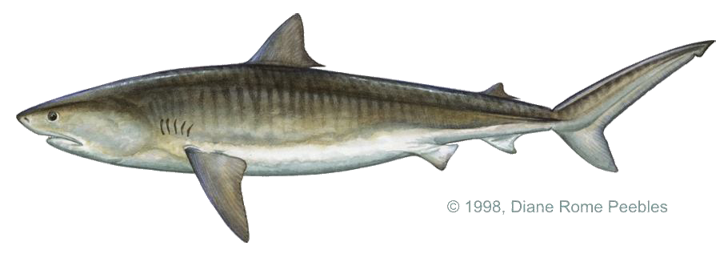Game Fish Identification Reference Guides
Shark, tiger
(Galeocerdo cuvier)
(Galeocerdo cuvier)

(Peron and Lesueur, 1822); CARCHARHINIDAE FAMILY; also called leopard shark
Occurs worldwide in tropical and warm temperate seas, but has been found during the summer season as far north as Massachusetts in the western Atlantic and Iceland in the eastern Atlantic.
The tiger shark can be readily identified by its cockscomb shaped, serrated teeth, which are recurvate and deeply notched on the inner margin. The teeth are the same in both jaws. The first two of the five gill slits are above the pectoral fin. There is a long, prominent keel along either side of the caudal peduncle. The young characteristically have very prominent, dark brown tiger stripes and leopard spots on the upper body and tail, but adults have less prominent markings.
It is especially dangerous to man because of its proneness to attack, and its tendency to occur in shallow waters where people swim. It is a sluggish swimmer under normal conditions, but comes alive in the presence of food, which considering the objects found in the stomachs of captured specimens, can be almost anything. In Australia, and Florida this shark has been responsible for many fatal attacks.
It is a hard fighting, highly rated game fish. Fishing methods include live bait fishing while chumming from boats or trolling. Whole or cut fish or scrap meat is effective. Many tiger sharks have been caught after attacking fish being played by anglers.
The tiger shark may give birth to from 10 to as many as 80 young in one litter. The flesh is not usually eaten, though it is certainly edible. Commercially, the hide is used to make leather, and fishermen use the flesh and liver for chumming
Occurs worldwide in tropical and warm temperate seas, but has been found during the summer season as far north as Massachusetts in the western Atlantic and Iceland in the eastern Atlantic.
The tiger shark can be readily identified by its cockscomb shaped, serrated teeth, which are recurvate and deeply notched on the inner margin. The teeth are the same in both jaws. The first two of the five gill slits are above the pectoral fin. There is a long, prominent keel along either side of the caudal peduncle. The young characteristically have very prominent, dark brown tiger stripes and leopard spots on the upper body and tail, but adults have less prominent markings.
It is especially dangerous to man because of its proneness to attack, and its tendency to occur in shallow waters where people swim. It is a sluggish swimmer under normal conditions, but comes alive in the presence of food, which considering the objects found in the stomachs of captured specimens, can be almost anything. In Australia, and Florida this shark has been responsible for many fatal attacks.
It is a hard fighting, highly rated game fish. Fishing methods include live bait fishing while chumming from boats or trolling. Whole or cut fish or scrap meat is effective. Many tiger sharks have been caught after attacking fish being played by anglers.
The tiger shark may give birth to from 10 to as many as 80 young in one litter. The flesh is not usually eaten, though it is certainly edible. Commercially, the hide is used to make leather, and fishermen use the flesh and liver for chumming












